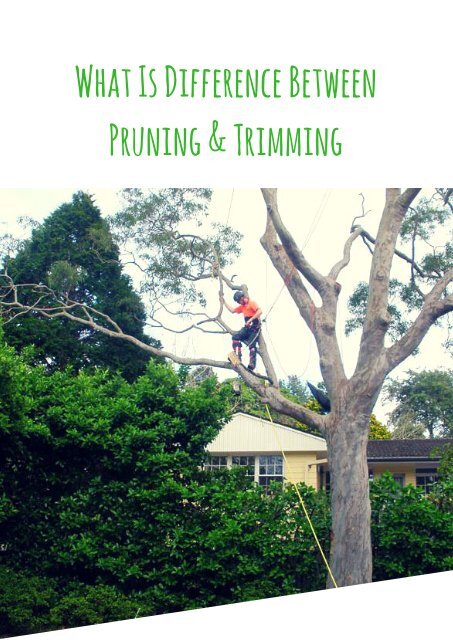What Is Difference Between Pruning and Trimming
Pruning and trimming are two techniques homeowners perform when taking care of their gardens.
Pruning and trimming are two techniques homeowners perform when taking care of their gardens.
You also want an ePaper? Increase the reach of your titles
YUMPU automatically turns print PDFs into web optimized ePapers that Google loves.
<strong>What</strong> <strong>Is</strong> <strong>Difference</strong> <strong>Between</strong><br />
<strong>Pruning</strong> & <strong>Trimming</strong>
<strong>Pruning</strong><br />
<strong>Pruning</strong> <strong>and</strong> trimming are two techniques homeowners<br />
perform when taking care of their gardens. <strong>Trimming</strong><br />
usually applies to maintaining small shrubs or hedges,<br />
while horticulturists use pruning for trees <strong>and</strong> shrubs. Both<br />
horticulture terms are used interchangeably but utilize<br />
different types of equipment <strong>and</strong> have different times for<br />
implementation. The end result of trimming <strong>and</strong> pruning<br />
are healthy <strong>and</strong> aesthetically appealing trees, shrubs <strong>and</strong><br />
hedges.<br />
The idea behind pruning is to prevent loose or dead<br />
branches from harming other plants or people. Removing<br />
these branches allows the tree's flowers <strong>and</strong> fruit to flourish.<br />
<strong>Pruning</strong> is not meant to stunt growth, but to stimulate the<br />
tree. Eliminating diseased or pest infested branches are<br />
other reasons gardeners prune their trees. Gardeners also<br />
prune if they want their tree to have a particular shape for<br />
aesthetic purposes. Two forms of pruning, pollarding <strong>and</strong><br />
topiary, cause trees to take on unnatural forms. Pollarding is<br />
the practice of pruning annually to produce new shoots on<br />
an annual basis. Topiary is the art of shaping trees into an<br />
animal or geometric shape.
<strong>Trimming</strong><br />
Equipment<br />
<strong>Trimming</strong> applies to tidying up a small shrub or hedge's<br />
appearance by removing overgrown branches. While pruning<br />
focuses on safety <strong>and</strong> a tree's health, gardeners usually trim<br />
shrubs <strong>and</strong> hedges for aesthetic purposes. However,<br />
excessive overgrowth is harmful since it reduces the amount<br />
of moisture <strong>and</strong> light a shrub receives, so gardeners should<br />
trim a shrub at least twice per year to prevent this from<br />
happening.<br />
Two types of shears are available for pruning: h<strong>and</strong> shears <strong>and</strong><br />
lopping shears. H<strong>and</strong> shears are meant to be h<strong>and</strong>led with one<br />
h<strong>and</strong> <strong>and</strong> are primarily used for removing small, easy to remove<br />
buds <strong>and</strong> leaves. Lopping shears have 1- to 2-foot long h<strong>and</strong>les<br />
<strong>and</strong> are meant for cutting off thick branches. The lopping shear's<br />
design allows gardeners to exert more force while cutting. If a<br />
branch is too thick for both shears, gardeners resort to saws for<br />
pruning. Both types of shears are viable options for trimming<br />
shrubs <strong>and</strong> hedges. A hedge trimmer is used for trimming a<br />
hedge's branches. Electric <strong>and</strong> gas-powered hedge trimmers are<br />
available.
Frequency<br />
The required frequency for pruning or trimming varies<br />
among plant species. Spring flowering trees need pruning<br />
during late June, immediately following the trees' blooming<br />
cycle. Winter <strong>and</strong> spring are appropriate pruning periods for<br />
summer flowering trees, says the University of Maryl<strong>and</strong>'s<br />
Cooperative Extension program. The most appropriate<br />
periods for trimming hinges on a shrub or hedge's<br />
appearance, rather than its health or flowering cycles.<br />
According to the University of Arizona College of Agriculture<br />
<strong>and</strong> Life Sciences, gardeners should trim their hedges before<br />
excessive branch growth reaches 1 foot.<br />
Article source<br />
Image source<br />
ehow.com<br />
look at this website



